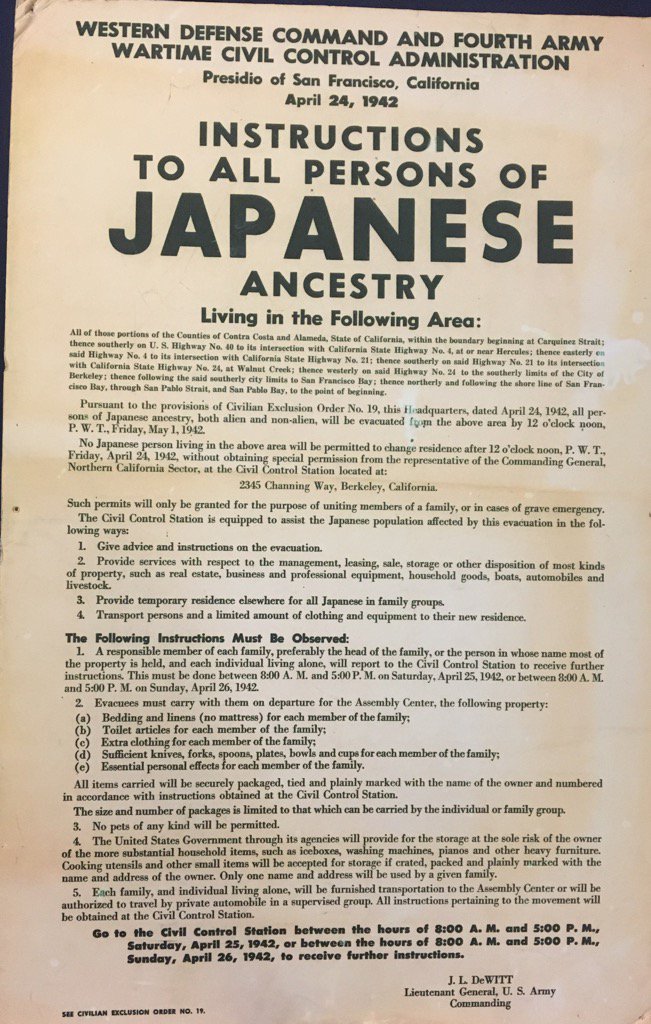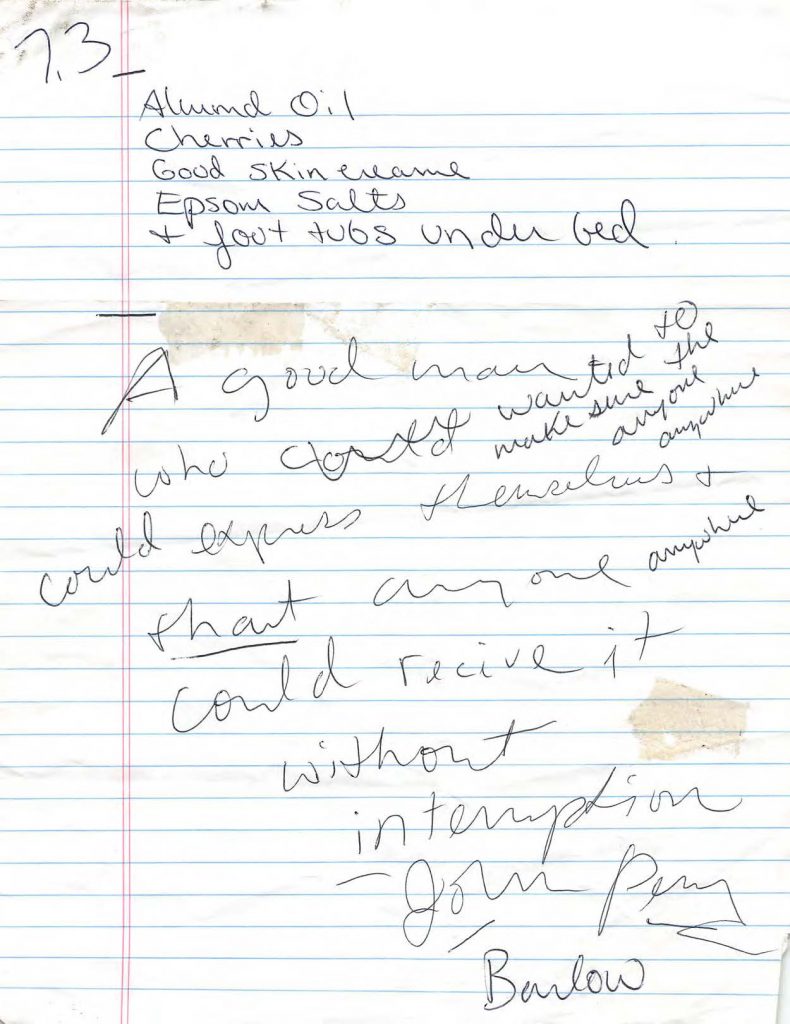
My dad found this Japanese Internment poster from 1942 at a garage sale a while back. I remember us looking at it together, and thinking about how far we had come as a nation, since then.
(This post is from November 17, 2016)
I was horrified to wake up this morning to the New York Times explaining that Donald Trump is seriously considering using a registration system for immigrants.
Kris Kobach, (NY Times, Huff Po), Trump supporter and, word has it, potential Attorney General (gulp), is actually suggesting that we might use something similar to the Japanese Internment program from WWII, as a model for how we should treat our Muslim immigrant brothers and sisters, today.
These posters, calling the internment an “evacuation,” were basically telling people of Japanese descent, that, if they lived in a certain area, they had one week to grab what they could carry and move to their local Internment Camp. (The notice was posted on April 24, and families were given until May 1, 1942.)
I’m not sure people realize what is actually being proposed here.
There was an official governmental study of Executive Order 9066 by a group of nine people that were appointed by the U.S. Congress in 1980, called Commission on Wartime Relocation and Internment of Civilians (CWRIC). (Executive Order 9066 is a United States presidential executive order signed by President Franklin D. Roosevelt on February 19, 1942 that authorizes the Secretary of War to prescribe certain areas as military zones, clearing the way for the deportation and “evacuation” of Japanese Americans.)
The CWRIC put out a report, Personal Justice Denied, which determined (on page 18, in the Summary of Part I) “The broad historical causes which shaped these decisions were race prejudice, war hysteria and a failure of political leadership.”
As the poster explains, families had exactly one week to sell or give away anything valuable and move. They were only allowed to bring bedding, a little clothing, toilet articles, silverware (one set per person) and “essential personal effects.”
A “Civil Control Station” was set up to answer questions and help Japanese citizens with selling all of their personal property. All “real estate, business and professional equipment, household goods, boats, automobiles and livestock” had to be sold or leased to others (presumably to someone of other than Japanese descent). Anything not sold, such as large appliances, could be stored by the U.S. government at the “sole risk of the owner.” You basically had a week to sell all of your stuff, pack up a small suitcase, and leave anything else behind. You had to be able to carry everything you brought by yourself too.
Here is the text of this poster:
WESTERN DEFENSE COMMAND AND FOURTH ARMY WARTIME CIVIL CONTROL ADMINISTRATION
Presidio of San Francisco, California – April 24, 1942
INSTRUCTIONS TO ALL PERSONS OF JAPANESE ANCESTRY
Living in the Following Area:
All of those portions of Counties of Contra Costa and Alameda, State of California, within the boundary beginning at Carquinez Strait; thence southerly on U.S. Highway No. 40 to its intersection with California State Highway No. 4, at or near Hercules; thence easterly on said Highway No. 4 to its intersection with California State Highway No. 21; thence southerly on said Highway No. 21 to its intersection with California State Highway No 24, at Walnut Creek; thence westerly on said Highway No. 24 to the southerly limits of the City of Berkeley; thence following the said southerly city limits to San Francisco Bay; thence northerly and following the shore line of San Francisco Bay, through San Pablo Strait, and San Pablo Bay, to the point of beginning.
Pursuant to the provisions of Civilian Exclusion Order No. 19, this Headquarters, dated April 24, 1942, all persons of Japanese ancestry, both alien and non-alien, will be evacuated from the above area by 12 o’clock noon, P.W.T., Friday May 1, 1942.
No Japanese person living in the above area will be permitted to change residence after 12 o’clock noon, P.W.T., Northern California Sector, at the Civil Control Station located at: 2345 Channing Way, Berkeley, California.
Such permits will only be granted for the purpose of uniting members of a family, or in cases of grave emergency.
The Civil Control Station is equipped to assist the Japanese population affected by this evacuation in the following ways:
1. Give advice and instructions on the evacuation
2. Provide services with respect to the management, leasing, sale, storage or other disposition of most kinds of property, such as real estate, business and professional equipment, household goods, boats, automobiles and livestock.
3. Provide temporary residence elsewhere for all Japanese in family groups.
4. Transport persons and a limited amount of clothing and equipment to their new residence.
The Following Instructions Must Be Observed:
1. A responsible member of each family, preferably the head of the family, or the person in whose name most of the property is held, and each individual living alone, will report to the Civil Control Station to receive further instructions. This must be done between 8:00 AM and 5:00 PM on Saturday, April 25, 1942, or between 8:00 AM and 5:00 PM on Sunday, April 26, 1942.
2. Evacuees must carry with them on departure for the Assembly Center, the following property:
(a) Bedding and linens (no mattress) for each member of the family;
(b) Toilet articles for each member of the family;
(c) Extra clothing for each member of the family;
(d) Sufficient knives, forks, spoons, plates, bowls and cups for each member of the family;
(e) Essential personal effects for each member of the family.
All items carried will be securely packaged, tied and plainly market with the name of the owner and numbered in accordance with instructions obtained at the Civil Control Station.
The size and number of packages is limited to that which can be carried by the individual or family group.
3. No pets of any kind will be permitted.
4. The United States Government through its agencies will provide for the storage at the sole risk of the owner of the more substantial household items, such as iceboxes, washing machines, pianos and other heavy furniture. Cooking utensils and other small items will be accepted for storage if crated, packed and plainly marked with the name and address of the owner. Only one name and address will be used by a given family.
5. Each family, and individual living alone, will be furnished transportation to the Assembly Center or will be authorized to travel by private automobile in a supervised group. All instructions pertaining to the movement will be obtained at the Civil Control Station.
Go to the Civil Control Station between the hours of 8:00 A.M. and 5:00 P.M., Saturday, April 25, 1942, or between the hours of 8:00 A.M. and 5:00 P.M., Sunday, April 26, to receive further instructions.
J.L. DeWITT
Lieutenant General, U.S. Army, Commanding
See Civilian Exclusion Order No. 19.
It is with a heavy heart that I had to resurrect my “Immigrant Roundups” category (started after the attacks of September 11, 2001 and the xenophobic policies that emerged soon after). I fear that the policies of Bush’s GOP will be nothing compared to President Trump’s GOP.



